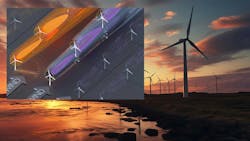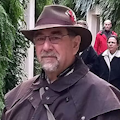New Aerodynamic Theory Could Improve Wind Farm Design and Operation
What you’ll learn:
- For the first time, engineers at MIT have developed a comprehensive, physics-based model that accurately represents the airflow around rotors even under extreme conditions.
- The new model enables the development of turbine control algorithms that lead to significantly higher operating efficiencies and lower losses due to turbulence.
- The aspects related to controlling both individual turbines and arrays of turbines can be implemented without modifying existing hardware in place within wind farms.
The blades of propellers and wind turbines are designed based on aerodynamics principles that were first described mathematically more than a century ago. But engineers have long realized that these formulas don’t work in every situation. To compensate, they added ad hoc “correction factors” based on empirical observations.
Now, for the first time, engineers at MIT have developed a comprehensive, physics-based model that accurately represents the airflow around rotors even under extreme conditions, such as when the blades operate at high forces and speeds, or are angled in certain directions. The model could improve the way rotors themselves are designed, but also the way wind farms are laid out and operated (see figure).
The new findings are described in the journal Nature Communications, in an open-access paper by MIT postdoc Jaime Liew, doctoral student Kirby Heck, and Michael Howland, the Esther and Harold E. Edgerton Assistant Professor of Civil and Environmental Engineering.1
“We’ve developed a new theory for the aerodynamics of rotors,” said Howland. This theory can be used to determine the forces, flow velocities, and power of a rotor, whether that rotor is extracting energy from the airflow, as in a wind turbine, or applying energy to the flow, as in a ship or airplane propeller. He added, “The theory works in both directions.”
Because the new understanding is a fundamental mathematical model, some of its implications could be applied right away. For example, operators of wind farms must constantly adjust a variety of parameters, including the orientation of each turbine as well as its rotation speed and the angle of its blades, to maximize power output while maintaining safety margins. The new model can provide a simple, speedy way of optimizing those factors in real-time.
“This is what we’re so excited about, is that it has immediate and direct potential for impact across the value chain of wind power,” said Howland.
Rotors: Modeling the Momentum
Known as momentum theory, the previous model of how rotors interact with their fluid environment—air, water, or otherwise—was initially developed late in the 19th century. With this theory, engineers can start with a given rotor design and configuration and determine the maximum amount of power that can be derived from the rotor. Conversely, if it’s a propeller, they’re able to determine how much power is needed to generate a given amount of propulsive force.
Momentum theory equations “are the first thing you would read about in a wind energy textbook, and are the first thing that I talk about in my classes when I teach about wind power,” said Howland. From that theory, physicist Albert Betz calculated in 1920 the maximum amount of energy that could theoretically be extracted from wind. Known as the Betz limit, this amount is 59.3% of the kinetic energy of the incoming wind.
But just a few years later, others found that the momentum theory broke down “in a pretty dramatic way” at higher forces that correspond to faster blade rotation speeds or different blade angles, noted Howland. It fails to predict not only the amount, but even the direction of changes in thrust force at higher rotation speeds or different blade angles.
Whereas the theory said the force should start going down above a certain rotation speed or blade angle, experiments show the opposite—that the force continues to increase. “So, it’s not just quantitatively wrong, it’s qualitatively wrong,” said Howland.
The theory also breaks down when there’s any misalignment between the rotor and the airflow, which Howland said is “ubiquitous” on wind farms, where turbines constantly adjust to changes in wind directions. In fact, in an earlier paper2 in 2022, Howland and his team found that deliberately misaligning some turbines slightly relative to the incoming airflow within a wind farm significantly improves the overall power output of the wind farm by reducing wake disturbances to the downstream turbines.
In the past, when designing the profile of rotor blades, the layout of wind turbines in a farm, or the day-to-day operation of wind turbines, engineers relied on ad hoc adjustments added to the original mathematical formulas. This was based on some wind tunnel tests and experience with operating wind farms, but with no theoretical underpinnings.
Modeling Aerodynamics to Determine Maximum Turbine Performance
Instead, to arrive at the new model, the team analyzed the interaction of airflow and turbines using detailed computational modeling of the aerodynamics. They found that, for example, the original model had assumed that a drop in air pressure immediately behind the rotor would rapidly return to normal ambient pressure just a short way downstream. But, according to Howland, it turns out that as the thrust force keeps increasing, “that assumption is increasingly inaccurate.”
And the inaccuracy occurs very close to the point of the Betz limit that theoretically predicts the maximum performance of a turbine—and, therefore, is just the desired operating regime for the turbines. Howland explained, “So, we have Betz’s prediction of where we should operate turbines, and within 10% of that operational set point that we think maximizes power, the theory completely deteriorates and doesn’t work.”
Through their modeling, the researchers also found a way to compensate for the original formula’s reliance on a one-dimensional modeling that assumed the rotor was always precisely aligned with the airflow. To do so, they used fundamental equations that were developed to predict the lift of three-dimensional wings for aerospace applications.
The researchers derived their new model, which they call a unified momentum model, based on theoretical analysis, and then validated it using computational fluid dynamics modeling. In follow up work not yet published, they are doing further validation using wind tunnel and field tests.
Beyond the Betz Limit
One interesting outcome of the new formula is that it changes the calculation of the Betz limit, showing that it’s possible to extract a bit more power than the original formula predicted. Although it’s not a significant change—on the order of a few percent—“it’s interesting that now we have a new theory, and the Betz limit that’s been the rule of thumb for a hundred years is actually modified because of the new theory,” said Howland. “And that’s immediately useful.”
The new model shows how to maximize power from turbines that are misaligned with the airflow, which the Betz limit can’t account for.
The aspects related to controlling both individual turbines and arrays of turbines can be implemented without requiring any modifications to existing hardware in place within wind farms. In fact, this has already happened, based on earlier work from Howland and his collaborators two years ago, which dealt with the wake interactions between turbines in a wind farm, and was based on the existing, empirically based formulas.
“This breakthrough is a natural extension of our previous work on optimizing utility-scale wind farms,” said Howland, because in doing that analysis, they saw the shortcomings of the existing methods for analyzing the forces at work and predicting power produced by wind turbines. “Existing modeling using empiricism just wasn’t getting the job done.”
In a wind farm, individual turbines will sap some of the energy available to neighboring turbines, because of wake effects. Accurate wake modeling is important both for designing the layout of turbines in a wind farm, and for the operation of that farm, determining moment to moment how to set the angles and speeds of each turbine in the array.
Until now, said Howland, even the operators of wind farms, the manufacturers, and the designers of the turbine blades had no way to predict how much the power output of a turbine would be affected by a given change, such as its angle to the wind, without using empirical corrections. He continued, “That’s because there was no theory for it. So, that’s what we worked on here. Our theory can directly tell you, without any empirical corrections, for the first time, how you should actually operate a wind turbine to maximize its power.”
Because the fluid flow regimes are similar, the model also applies to propellers, whether for aircraft or ships, as well as for hydrokinetic turbines like tidal or river turbines. Although they didn’t focus on that aspect in this research, he said “it’s in the theoretical modeling naturally.”
The new theory exists in the form of a set of mathematical formulas that a user could incorporate in their own software, or as an open-source software package that can be freely downloaded from GitHub. “It’s an engineering model developed for fast-running tools for rapid prototyping and control and optimization,” said Howland. “The goal of our modeling is to position the field of wind energy research to move more aggressively in the development of the wind capacity and reliability necessary to respond to climate change.”
The work was supported by the National Science Foundation and Siemens Gamesa Renewable Energy.
References
1. Jaime Liew, Kirby S. Heck, Michael F. Howland, "Unified Momentum Model for Rotor Aerodynamics Across Operating Regimes", January 2024, https://arxiv.org/abs/2401.09623.
2. Howland, M.F., Quesada, J.B., Martínez, J.J.P. et al., “Collective wind farm operation based on a predictive model increases utility-scale energy production,” Nat Energy 7, 818–827 (2022). https://doi.org/10.1038/s41560-022-01085-8.
About the Author
Lee Goldberg
Contributing Editor
Lee Goldberg is a self-identified “Recovering Engineer,” Maker/Hacker, Green-Tech Maven, Aviator, Gadfly, and Geek Dad. He spent the first 18 years of his career helping design microprocessors, embedded systems, renewable energy applications, and the occasional interplanetary spacecraft. After trading his ‘scope and soldering iron for a keyboard and a second career as a tech journalist, he’s spent the next two decades at several print and online engineering publications.
Lee’s current focus is power electronics, especially the technologies involved with energy efficiency, energy management, and renewable energy. This dovetails with his coverage of sustainable technologies and various environmental and social issues within the engineering community that he began in 1996. Lee also covers 3D printers, open-source hardware, and other Maker/Hacker technologies.
Lee holds a BSEE in Electrical Engineering from Thomas Edison College, and participated in a colloquium on technology, society, and the environment at Goddard College’s Institute for Social Ecology. His book, “Green Electronics/Green Bottom Line - A Commonsense Guide To Environmentally Responsible Engineering and Management,” was published by Newnes Press.
Lee, his wife Catherine, and his daughter Anwyn currently reside in the outskirts of Princeton N.J., where they masquerade as a typical suburban family.
Lee also writes the regular PowerBites series.


